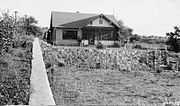Canelo Ranger Station, also known as Canelo Work Station, is a historic ranger station located in the ghost town of Canelo, Arizona, in a small valley between the Canelo Hills to the west and the northern end of the Huachuca Mountains to the east. It was built by the United States Forest Service (USFS) and the Civilian Conservation Corps (CCC) in the early-1930s and was listed on the National Register of Historic Places in 1993 for its architecture. The listing includes five contributing buildings on a 3-acre (1.2 ha) property, designed by USFS architects in Bungalow/Craftsman style.[1][2]
History
Construction of the Canelo Ranger Station began in November 1932, before the establishment of the CCC, which was responsible for building and improving many of Arizona's ranger stations during the Depression era. Work was first started on a new adobe house, or residence, for the rangers. During excavations for the construction of the basement, Forest Service workers unearthed a redwood coffin containing the remains of local pioneer Captain Joe Parks. Parks had settled in the Canelo area in 1882. After dealing with him, concrete was poured to form the basement, which was finished in early December, when work ceased for the winter.[2][3]
On June 16, 1933, it was reported that the construction of the Canelo Ranger Station was finished with the completion of a small adobe barn, made from scrap materials salvaged from an older ranger station house. In addition to the residence and barn, a new office building, a three-bay garage and a small pumphouse along nearby Turkey Creek were also constructed, all of adobe brick. The office is identical in plan to the Patagonia and Lowell Ranger Station offices, but instead of a flat adobe roof common to desert settings, it features a wooden gabled roof, meant to fit in with the surrounding woodland environment.[2][3]
Not long after the establishment of the Canelo Ranger Station, the CCC arrived and was put to work building the stone retaining walls around the office and residence, improving the roads, landscaping and building corrals. The retaining walls are still intact, along with most of the rest of the station, which has changed very little over the years. Although a few additions and other minor modifications have been made, the overall appearance of the station remains very much like it did when it was first built in the 1930s. The station is thus considered to be a good representation of a USFS administrative site from the Depression era and is also significant for its association with the expansion of the USFS from a custodial superintendence role to active resource management, which continues to this day.[2]
Contributing buildings
The following are the contributing buildings listed on the National Register of Historic Places:
- Office: Bungalow/Craftsman style adobe building with two entrances, two offices and a bathroom
- Residence: Bungalow/Craftsman style adobe building with two bedrooms, a bathroom, living room, kitchen, dining room and basement
- Garage: Long adobe building with a wooden gabled roof, one entrance and three bays
- Barn: Small adobe building with a wooden gabled roof, next to horse corral
- Pumphouse: Small adobe building with a wooden gabled roof, now used for storage
Gallery
| Construction of the office building at the Canelo Ranger Station in 1933. |
| A CCC photo of the ranger station residence. |
| The residence (left) and the garage. |
| The small barn next to a horse corral. |
| The pumphouse and well along Turkey Creek. |
| The barn and the horse corral. |
| The horse corral with the barn in the background. |
| The Canelo Fire Center sign just outside of the entrance to the ranger station. |
|
See also
References
|
|---|
| | Topics | |
|---|
| | Lists by states | |
|---|
| | Lists by insular areas | |
|---|
| | Lists by associated states | |
|---|
| | Other areas | |
|---|
|
-
 Category Category
-
 Portal Portal
-
 WikiProject WikiProject
|
|

